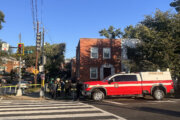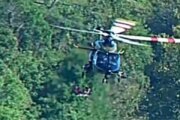When a couple of historic heatwaves sent temperatures in the Pacific Northwest soaring above 100 degrees Fahrenheit in June, Providence Mount St. Vincent, a large senior residential facility in Seattle, was prepared.
Most of the rooms and common areas at “the Mount,” as the three-building facility is known, aren’t air conditioned. Members of the Mount’s staff borrowed a handful of large, commercial-grade air conditioning units from a nearby hospital. They are both part of a regional network of health care facilities that support each other during emergencies. The air conditioning units cooled common areas. Staff members used the cafeteria, one of the few areas with central air conditioning, as a cooling and hydration center, encouraging residents affected by the heat to spend time there and drink water.
To keep the brick buildings cool, the cafeteria switched to a cold menu, so workers wouldn’t have to use ovens. When a staff member alerted a community blog that some residents at the Mount could use small portable air conditioning units and fans; area residents responded with dozens of contributions.
The response — part of The Mount’s emergency preparedness plan — worked. No residents suffered serious effects from the heat, and none needed to be transferred to other facilities.
[Read: ‘SOS Team’ Fights COVID-19 at Skilled Nursing Facilities.]
How Emergency Preparedness Plans are Created
“While it may not be the first thing consumers think about when considering a skilled nursing home for their loved ones, emergency preparedness plans are more important than ever, particularly with climate change creating more extreme weather events like the flooding we’ve seen lately,” says Laura Van Eperen, chief executive officer of FOVNDRY, a strategic communications and consulting firm based in Rockville, Maryland. The firm works with several senior living communities.
Nursing homes (and the 16 other types of health care providers and suppliers, such as critical access hospitals, hospices and psychiatric residential treatment facilities) that participate in Medicare and Medicaid must adhere to the federal government’s emergency preparedness rule, says Courtney Bishnoi, vice president of quality and programs at American Health Care Association and National Center for Assisted Living (AHCA/NCAL), based in Washington, D.C. The rule mandates that these facilities develop plans adhering to an “all-hazards approach” that includes natural, human and technological events, according to AHCA/NCAL.
Examples that would fall are under “man-made” emergencies include:
— Equipment failures.
— Interruptions in communications, including cyber-attacks.
— The loss of a portion or all of a building, such as from a collapse or partial collapse.
Nursing homes must also prepare for emergency infectious disease threats, including
— Influenza.
— Ebola.
— The Zika virus.
“Having a plan in place for emergencies is essential,” says U.S. Rep. Bill Pascrell, a New Jersey Democrat who chairs the House Ways and Means Committee on Oversight. “When the next tragedy or contagion strikes, we cannot be caught flat-footed.”
[READ: Nursing Homes vs. Assisted Living.]
Evaluating a Nursing Home’s Plan
Keep in mind, nursing homes must follow both federal and state requirements. To see how a facility fares with state regulatory agencies, check with the state department that oversees licensing for nursing homes. In Washington state, for example, it’s the Department of Social and Health Services.
Many nursing homes follow the federal government’s emergency preparedness checklist in developing their plans, making sure the strategy is tailored to the facility’s needs. These preparations are typically led by the nursing home administrator, but they’re collaborative efforts that include staff members from all parts of the facility.
For example, at the Mount, the disaster preparedness and safety committee, which consists of staff members from all parts of the facility, does an annual comprehensive review of the emergency plan. The panel also meets monthly to address ongoing safety issues.
Contributors to the emergency preparedness plans of nursing homes can include workers from:
— Education and training.
— Environmental services.
— Food services.
— Housekeeping.
— IT.
— Nursing.
— Recreation.
— Training.
Many nursing home facilities — like the Mount — incorporate memberships in regional and local health care networks as part of their emergency preparedness plans. Long-term care facilities must review and update their plans annually. They have to be able to show their updates annually to the federal Centers for Medicaid and Medicare Services and typically state authorities too.
[See: Beyond Bingo: Innovative Activities at Today’s Nursing Homes.]
Types of Emergencies That Require a Plan
It’s also pro forma for nursing homes to conduct periodic emergency preparedness training exercises. For example, staff at the Mount have conducted evacuation drills for scenarios such as earthquakes and compromised or collapsing buildings, says Charlene Boyd is the administrator at Providence Mount St. Vincent. Boyd reviews and approves the Mount’s emergency preparedness plan, including a highly-detailed evacuation strategy.
Nursing home administrators also plan for emergencies, like heavy snowstorms, that can make it challenging for staff members to get to the nursing home.
Emergencies that nursing home officials prepare for include:
— Compromised or collapsed buildings.
— Cyber attacks.
— Disrupted food or water supply.
— Earthquakes.
— Fires.
— Snowstorms.
— Hurricanes.
— Pandemics.
— Power outages.
What to Look for in an Emergency Preparedness Plan
If you’re considering a nursing home for a loved one or yourself, it’s important to know what to look for in an emergency preparedness plan, Boyd says.
Here are four questions to ask your nursing home administrator regarding a nursing home’s emergency preparedness plan:
1. Can I see the plan?
Ask for a copy of the emergency preparedness plan, Boyd says. The plan should provide specific response strategies for different emergency scenarios. It should also include a plan for the nursing home’s staff to communicate with family members and other loved ones during a state of emergency.
The plan will also typically include information on training drills the staff has conducted. Ask to speak to a member of the safety committee and to review the minutes of the panel’s meeting. Safety committee meetings could reveal security issues that were discussed and whatever actions the panel decided on to resolve those questions.
2. What do fire inspection reports say?
Typically, state and local fire department authorities will conduct annual inspections and document any potential safety concerns. They check such things as egress, whether fire doors close and seal and check on the status of emergency equipment, like fire extinguishers.
These reports are public. Some nursing homes have them on hand, and you have a right to see them. If the facility doesn’t have such reports on hand, consumers can get such reports from whichever state entity licenses nursing homes.
3. Does the facility have community partnerships with other health care facilities and first responders, like the fire department?
Being part of a local or regional network of health care providers is an important part of an emergency preparedness plan. Partners in such coalitions can support each other by providing equipment, staff and, if necessary, space to transfer evacuated residents.
4. In the event of an emergency, what’s the communications plan? Residents and family members should ask about the facility’s methods of communication in the event of an emergency, Bishnoi says.
“It’s important for consumers to understand that nursing home staff may only communicate with a designated representative for each resident about their specific condition due to health privacy issues. So, especially in a crisis, work together as a family unit to get the latest information from the nursing home about your loved one. The facility may also provide general updates through broader communication channels, like social media or an email listserv. Work with the facility ahead of time to get signed up for their alerts.”
The COVID-19 pandemic and extreme weather events throughout the country underscore the importance of learning a nursing home’s emergency perparedness plan, says Dr. Jennifer Attmore, a geriatric medicine specialist at Texas Health Presbyterian Hospital Plano in Plano, Texas. She’s also a member of Texas Health Adult Care, a Texas Health Physicians Group practice.
“As we’ve learned with COVID-19, the unexpected can pose a very real threat,” Attmore says.
More from U.S. News
7 Signs You’re Not Getting Enough Vitamin B12
7 Habits for a Long, Healthy Life
8 Calcium-Rich, Nondairy Foods
How to Evaluate a Nursing Home’s Disaster Plan originally appeared on usnews.com







